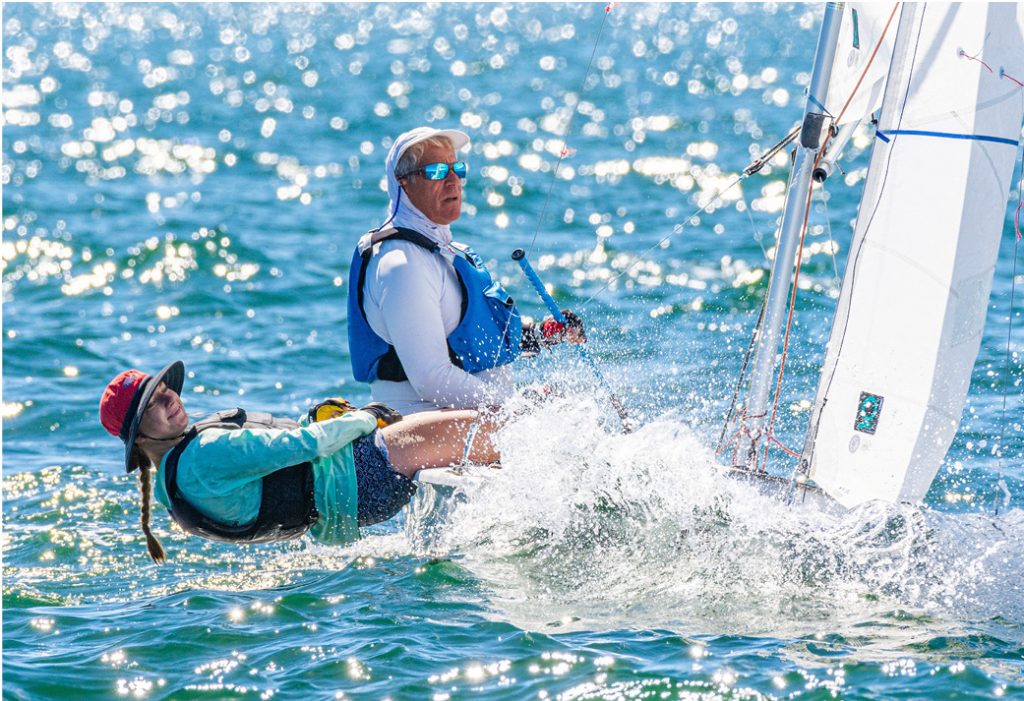Before we talk about how you can use sail controls to change the shape of your headsail, let’s quickly review how we look at that shape in the first place. Let’s discuss how the various headsail controls affect four basic measures of sail shape: overall depth (fullness), the position of maximum draft, the leading edge angle and twist. Each of these has a large effect on the sail’s total power and performance.
Depth of the sail – The depth (also called fullness or draft) of the jib/genoa is essentially a measure of the sail’s roundness. A sail that is very curved is also quite deep. In general, depth produces power so a deeper sail is more powerful than a flatter one (but also has more drag).
Almost all the headsail controls affect the depth of the sail. Pulling on the backstay, for example, reduces headstay sag and flattens the sail. Moving the jib lead aft makes the bottom of the sail flatter, while more tension on the jib halyard pulls draft out of the sail.
It’s usually good to have a relatively full sail in light air or whenever you have more waves than wind, and a flatter sail in flat water or moderate air (for pointing) or in heavy air to depower. Because the jib is in a perpetual lift created by the mainsail, jibs are usually a bit deeper than mainsails.
Position of maximum draft – For most jibs and genoas, the deepest part of the sail should be a bit forward of the center of the sail – roughly 40 to 45% of the way from luff to leech. You can move the draft forward by generating more luff sag, or by pulling harder on the jib halyard (or jib cunningham) to get more luff tension. You can move the draft aft by reducing luff sag or decreasing luff tension.

The purpose of having sail controls is so you can optimize the shape of the headsail for the existing wind and wave conditions. On most boats, one all-purpose jib has to morph from a deep light-air shape to a flatter shape for heavier wind. © Bruce Durkee
Leading edge angle – The leading edge angle is a measure of the roundness of the forward part of the jib. If the front of the jib is flat (fine), the sail can point high but it will be ‘critical’ (i.e. always on the edge of stalling) and hard to keep in the groove. A genoa with a rounder luff won’t point as high, but it will be more forgiving and will give the helmsperson a wider ‘groove.
Twist – Twist is the change in the angle of the sail’s chordline as you go from the bottom to the top of the headsail. Every jib has at least some twist (because the wind blows the leech to leeward). In general, you want more twist in light air, waves and in heavy air when you need to depower the sailplan. Minimize twist in ideal pointing conditions with moderate air and flat water.
Make your jib more forgiving
There are several things a trimmer can do to make the jib or genoa more forgiving and get a wider groove.
1. Ease the sheet – This is the top priority because it’s easy to do and has a huge effect. A tightly trimmed headsail has a very narrow range where it’s fast –it will easily stall and go slow, especially in light air or waves. Avoid this by easing the sheet to add twist, let the sail breathe and encourage the helm to sail lower and faster.
2. Make the sail fuller – A deeper sail is more powerful, which makes it easier for the helmsperson to maintain speed. This hurts pointing, but in marginal conditions you should set up the jib so the helmsperson is not tempted to point very high.
3. Move draft forward – Make the front of the jib rounder (by increasing headstay sag and luff tension) to make it easier for the wind to stay attached to the sail. ■
This article originally appeared in David Dellenbaugh’s Speed & Smarts, The newsletter of how-to tips for racing sailors. If you want to sail faster and smarter, log onto SpeedandSmarts.com.
A resident of Easton, CT, Dellenbaugh was tactician and starting helmsman for America3’s successful defense of the America’s Cup in 1992. He’s a Lightning World Champion, two-time Congressional Cup winner, seven-time Thistle National Champion, two-time winner of the Canada’s Cup, three-time Prince of Wales U.S. Match Racing Champion, and a winner of the U.S. Team Racing Championships for the Hinman Trophy.



